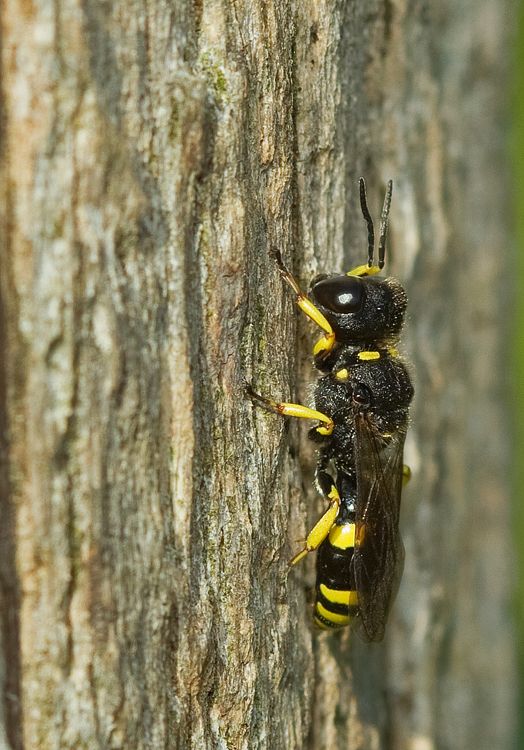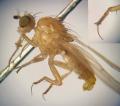Diptera.info :: Identification queries :: Other insects, spiders, etc.
|
Small bee/wasp
|
|
| Paul Cools |
Posted on 20-07-2016 15:54
|
|
Member Location: Tilburg Posts: 176 Joined: 26.06.16 |
Photographed two days ago in Tilburg (The Netherlands |
| ValerioW |
Posted on 20-07-2016 16:42
|
|
Member Location: Padova - Italy Posts: 982 Joined: 01.06.12 |
Crabronidae. Looks like a Cerceris sp. Do you have another photo where to check better femora 3? So I can confirm the genera |
|
|
|
| Paul Cools |
Posted on 21-07-2016 15:45
|
|
Member Location: Tilburg Posts: 176 Joined: 26.06.16 |
too bad its the only pic that i got, it was gone after two clicks.... |
| ValerioW |
Posted on 21-07-2016 15:56
|
|
Member Location: Padova - Italy Posts: 982 Joined: 01.06.12 |
Paul Cools wrote: too bad its the only pic that i got, it was gone after two clicks.... Anyways, we know the family!  |
|
|
|
| Juergen Peters |
Posted on 21-07-2016 17:12
|
|
Member Location: northwest Germany Posts: 14332 Joined: 11.09.04 |
ValerioW wrote: Crabronidae. Looks like a Cerceris sp. I think, Ectemnius. Best regards, Jürgen -=-=-=-=-=-=-=-=-=-=-=-=-=-=-=-= Juergen Peters Borgholzhausen, Germany WWW: http://insektenfo... -=-=-=-=-=-=-=-=-=-=-=-=-=-=-=-= |
| ValerioW |
Posted on 21-07-2016 17:58
|
|
Member Location: Padova - Italy Posts: 982 Joined: 01.06.12 |
Juergen Peters wrote: ValerioW wrote: Crabronidae. Looks like a Cerceris sp. I think, Ectemnius. Can be, but without checking wing we cannot be certain about its subfamily |
|
|
|
| John Carr |
Posted on 21-07-2016 18:34
|
|
Super Administrator Location: Colorado, USA Posts: 10536 Joined: 22.10.10 |
ValerioW wrote: Juergen Peters wrote: ValerioW wrote: Crabronidae. Looks like a Cerceris sp. I think, Ectemnius. Can be, but without checking wing we cannot be certain about its subfamily Is the head shape not sufficiently distinctive? |
| ValerioW |
Posted on 21-07-2016 18:45
|
|
Member Location: Padova - Italy Posts: 982 Joined: 01.06.12 |
John Carr wrote: ValerioW wrote: Juergen Peters wrote: ValerioW wrote: Crabronidae. Looks like a Cerceris sp. I think, Ectemnius. Can be, but without checking wing we cannot be certain about its subfamily Is the head shape not sufficiently distinctive? Never heard/read about this character. Where have you found it? About head, antennae are in a frequent posture of Ectemnius, but I don't see other things. Edited by ValerioW on 21-07-2016 18:49 |
|
|
|
| piros |
Posted on 21-07-2016 19:18
|
|
Member Location: Szeged, Hungary Posts: 1815 Joined: 04.01.12 |
I also think it is an Ectemnius male (antannae looks characteristic enough.) I would even risk suggesting Ectemnius continuus as a tentative ID. (Wing venation would not really help, it is the same in a number of genera within Crabronini.) Greetings, Henrik |
|
|
|
| John Carr |
Posted on 21-07-2016 20:20
|
|
Super Administrator Location: Colorado, USA Posts: 10536 Joined: 22.10.10 |
I didn't know you had Ectemnius continuus. I have seen it a few times in USA. This does look similar. Among North American species, according to an expert in the group, it is distinguished from most by the all-black third tergite and from all by a "small inner process on the second tarsomere of the male mid tarsus". On BugGuide subfamily Crabroninae is named "square-headed wasps". http://bugguide.n...520/bgpage |
| ValerioW |
Posted on 21-07-2016 20:56
|
|
Member Location: Padova - Italy Posts: 982 Joined: 01.06.12 |
piros wrote: I also think it is an Ectemnius male (antannae looks characteristic enough.) I would even risk suggesting Ectemnius continuus as a tentative ID. (Wing venation would not really help, it is the same in a number of genera within Crabronini.) Greetings, Henrik Indeed Cerceris is not from tribe Crabronini, and not even from subfamily Crabroninae. And how can you say is a continuus and not a rubicola from this photo? |
|
|
|
| piros |
Posted on 21-07-2016 21:07
|
|
Member Location: Szeged, Hungary Posts: 1815 Joined: 04.01.12 |
In the region where I live (S. Hungary), E continuus is by far the most frequent Ectemnius sp. Here, most, but not all, specimens have black third tergite. In the case of males, the shape of the lower surface of the antennae, when clearly seen, is sufficient to distinguish it from other Central European/Hungarian species. That's the reason I think it could be that sp. |
|
|
|
| piros |
Posted on 21-07-2016 21:09
|
|
Member Location: Szeged, Hungary Posts: 1815 Joined: 04.01.12 |
Of course, it is a tentative ID, and not 100%! |
|
|
|
| ValerioW |
Posted on 21-07-2016 21:15
|
|
Member Location: Padova - Italy Posts: 982 Joined: 01.06.12 |
piros wrote: In the region where I live (S. Hungary), E continuus is by far the most frequent Ectemnius sp. Here, most, but not all, specimens have black third tergite. In the case of males, the shape of the lower surface of the antennae, when clearly seen, is sufficient to distinguish it from other Central European/Hungarian species. That's the reason I think it could be that sp. I see piros. But rubicola is really similar to that species. You need to check propodeum, clypeus, and the full antennae, in females, while is important to evaluate tarsomeres in males |
|
|
|
| piros |
Posted on 21-07-2016 21:20
|
|
Member Location: Szeged, Hungary Posts: 1815 Joined: 04.01.12 |
That's why it is a "tentative" ID 
Edited by piros on 21-07-2016 21:22 |
|
|
|
| ValerioW |
Posted on 21-07-2016 21:33
|
|
Member Location: Padova - Italy Posts: 982 Joined: 01.06.12 |
piros wrote: That's why it is a "tentative" ID  Sure, most of IDs, by non macro/micro detailed photos are. But better to use known characters, otherwise the ID wont'be realiable  |
|
|
|
| piros |
Posted on 21-07-2016 22:23
|
|
Member Location: Szeged, Hungary Posts: 1815 Joined: 04.01.12 |
Well, the second flagellomere in the photo is discernible, and clearly longer than that of (male) E. rubicola. I consider this a reliable character. Don't you? |
|
|
|
| ValerioW |
Posted on 22-07-2016 06:26
|
|
Member Location: Padova - Italy Posts: 982 Joined: 01.06.12 |
piros wrote: Well, the second flagellomere in the photo is discernible, and clearly longer than that of (male) E. rubicola. I consider this a reliable character. Don't you? I'm sorry, but the answer is: No. Length isn't a useful character in this specific case. To distinguish these two species the 3rd antennomere is a useful character, but it's not used its length, while a ratio of its dimensions  Juergen, I'm quite sure, was right saying Ectemnius ...even if we cannot stress its characters. BTW: Yesterday I verified, and rubicola can be excluded (because of the ratio of its 3rd antenna's ratio L/W). Problem is that its ratio exceeds that of a continuus (>2!!). Edited by ValerioW on 22-07-2016 06:40 |
|
|
|
| piros |
Posted on 23-07-2016 13:12
|
|
Member Location: Szeged, Hungary Posts: 1815 Joined: 04.01.12 |
OK, I am not a paid advocate of Ectemnius continuus Ltd... Ectemnius sp. is fine with me  Just thought it worth considering E. continuus, since color pattern agrees, shape and proportion of antennal segments (BTW, I don't think you can reliably mesure L/W ratio in the photo) agrees (in my view!) with that sp. That's all. Just thought it worth considering E. continuus, since color pattern agrees, shape and proportion of antennal segments (BTW, I don't think you can reliably mesure L/W ratio in the photo) agrees (in my view!) with that sp. That's all.Best regards, Henrik Edited by piros on 25-07-2016 18:35 |
|
|
|
| Jump to Forum: |













